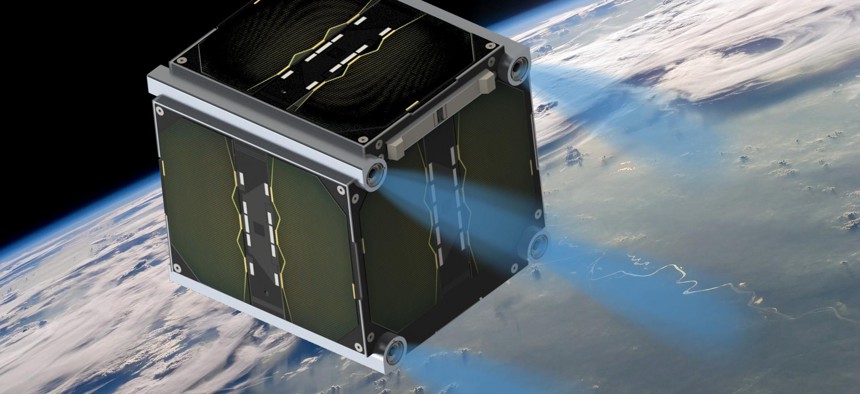
An artist rendition of Morpheus Space nano thrusters on a 1U CubeSat. Morpheus Space
CIA’s In-Q-Tel Among Backers of German Satellite-Thruster Startup
Morpheus Space’s small and simple electric thrusters could upend the satellite industry.
The Central Intelligence Agency’s venture capital firm is among a half-dozen investors in Morpheus Space, a German startup whose novel electric thrusters enable tiny satellites to maneuver and big ones to reduce complexity.
The Dresden-based company said it plans to use the capital to hire employees, increase production and expand its business to the United States. While the company won’t say how much money it raised, it listed In-Q-Tel along with other investors VSquared Ventures, Lavrock Ventures, Airbus Ventures, Pallas Ventures and TechStars. The startup’s leaders hope the money will allow it to enter the defense, civil, and commercial space markets.
Morpheus Space’s “unique propulsion systems are poised to revolutionize the space industry,” said Richard Spencer, who stepped down as Navy secretary last year and is now managing director of Pallas Ventures, in an emailed statement. Spencer is also on the firm’s board of directors and is helping with U.S. expansion.
While the company plans to continue manufacturing the thrusters in Germany, Morpheus plans to open an office in Los Angeles and is considering a second U.S. office on the East Coast.
The company’s thrusters allow even cheap cube satellites to become maneuverable spacecraft, allowing operators to move them for different missions or avoid collisions with space debris. Typically only larger, more expensive satellites have the thrusters necessary to maneuver in space.
Six Morpheus thrusters are already in space aboard two university satellites. In June, Morpheus thrusters moved a 10-centimeter, or 1U, cubesat out of the path of a disabled Iridium satellite, marking the first time a satellite of this class performed a collision avoidance maneuver, István Lőrincz, the company’s chief business officer and co-founder, said. Without the four electric thrusters, the two satellites would have likely crashed into one another.
“This is the first CubeSat that actually had an electric propulsion system on board and could successfully operate the propulsion system,” Lőrincz said. “No other CubeSat has the capability.”
Lőrincz called the thrusters “the smallest and most efficient propulsion system for satellites that has space qualification.”
The smallest thrusters are about the size of a fingertip — the larger ones about the size of a rubix cube. A modular design means they could be used on satellites as little as 1 kilogram or more than a ton.
They’re modular, and can go on satellites as small as 1 kilogram and as large as a ton.
“It's a building block, actually, like a Lego brick,” said Daniel Bock, the company’s CEO and co-founder. “
The thrusters also use a metal propellant, eliminating the need for tanks and tubes needed for gas fuel.
“It's basically a solid block of metal, which makes it very easy to launch, Bock said.
The solid fuel could power the thrusters longer than the satellites design life.
“So the satellite would die sooner than the fuel was run out,” Lőrincz said. “So essentially, from the satellites point of view, it's infinite.”
As for cost: “We can meet the pricing of any comparable propulsion systems price,” he said.
Morphus also touted what executives described as “autopilot-like software” for firing its thrusters.
“No one is using an autopilot for the satellites — the orbits and all the maneuvers, are controlled manually from the ground by experts,” Bock said.
Space is a niche area where startups have been able to win business, but it's no easy feat competing against multibillion behemoths like Lockheed Martin, Boeing and Northrop Grumman.
“Everyone knows that the current acquisition system is not ... adequate to implement or assimilate emerging technologies that are innovative, that are revolutionary,” Lőrincz said.
He touted the U.S. Air Force and U.S. Space Force leaders’ use of pitch days and other work around to get access to cutting-edge commercial technology.
“A lot of ambitious leaders within the government, the U.S. Air Force [and] Space Force ... are working to create workarounds to make it possible that startups can have a significant impact within the government,” Lőrincz said. “But it's still not enough.”
Don't miss:
NEXT STORY: Here’s What Might Not Survive COVID Budget Cuts





